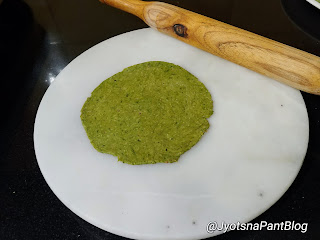 |
| Bathua Poori |
Bathua (Chenopudium Album) is widely grown in Northern part of India and is a winter vegetable. It is also known as Goose foot, Pigweed, Lamb's- quarter, Wild spinach. The edible part is leaves and sometimes very render stem.
Bathua is added to Sarson (mustard leaves) along with spinach to make Sarson ka saag.
Bathua raita and bathua poori /parantha, bathua stuffed parantha are my favorite.
Preparation Time: 30 minutes
Cooking Time : 20 minutes (boiling bathua, making poori)
Servings: 25 pooris
Nutritional value of 100 gm Bathua:
Water: 92.5 gm
Carbs: 2.25gm
Fats :0.5gm
Proteins : 0.98gn
Dietary Fibers :2.21gm
Ash: 1.57 gm
Sodium: 237 mg
Potassium : 427 mg
Iron :1.01 mg
Calcium:69 mg
Magnesium : 76 mg
Phosphorus : 52 mg
Zinc: 0.41
Vitamin A, B6(carotene), C
Ingredients Required for Making Bathua Poori :
The cup taken for all measurements it should be same.
The cup taken by me for measurement is of 150 ml capacity.
- Whole wheat flour (atta) : 1 cup (100 gm)
- Samolina : 1/4cup (25 gm)
- Corn flour : 2Tablespoons
- Ghee (refined butter)/cooking oil:4 Teaspoons
- Bathua paste: 1/2 cup
- Salt : 1 Teaspoon
- Carrom seeds (Ajwain) :1 Teaspoon
- 15 ml water for making dough.
- 20 ml water for cooking bathua.
- Oil for frying
Directions For Making Bathua Poori :
Step 1: Making Bathua paste :
- Remove leaves from stem. Wash them thoroughly. Drain excess the water.
- In a thick bottom pan take 20ml water add 1 teaspoon salt and boil the water.
- Once water boils add cleaned bathua leaves. Cover and switch off the heat.
- Let it cool. The leaves will get nicely wilted and become soft without loosing it's beautiful green color.
- Pulse the leaves with all the juices in the pan to make soft silky paste.
Step 2: Making Dough :
- In a kneading plate/any cook ware take :
- Atta
- Maida
- Suji
- Cornflour
- Make a well in the center and add :
- Salt
- 4 teaspoons melted ghee /oil
- Carrom seeds (Ajwain)
- Mix nicely using your fingers. The mixture will look like bread crumbs.
- Add Bathua paste and mix nicely. Knead the mixture to make dough adding water in small proportion while kneading the dough. This is done to avoid adding excess water and dough to becoming loose not firm.
- Knead the dough go 2-3 minutes so that it becomes firm but pliable.
- Cover the dough with a moist cloth and let it rest for 15 minutes.
- Knead the dough again and if it has become little hard (due to sooji absorbing water) sprinkle little water whole kneading.
- Heat cooking oil in a wok/frying pan.
- Take small portion of dough, apply 2drops of oil on both sides. Roll the dough ball to a round 1mm (approximately) thick disc (poori)
- Fry in hot oil (not smoking hot) on both sides.
- Serve hot Bathua poories with curd /riata, chutney /pickle. I love these poories with allooo-tamatar ki sabzi.
 |
| Bathua Poori |
Tips:
- Since water taken for cooking bathua is very less so make sure heat is switched off and pan is covered after adding bathua to boiling water.
- While making paste of Bathua do not boil the bathua because it will loose it's shiny greeny color.
- Add water in very small portion while kneading they dough.
- Oil while frying should be hot but never smoking hot. Smoking hot oil will spoil the color of poori also the poories will get dark color quickly but remain uncooked from inside.
- Ghee gives very good texture to poori. So I prefer ghee over oil for making dough.
Suggested Variations :
- Corn flour makes poori crispier, but if one want can omit it.
- Maida can be replaced by rice flour or whole wheat flour.
- 1 or two green chilies can be added to bathua before pulsing it and making it's paste.
- Instead of water more bathua paste( if there is extra left) can be used for making dough, by adding spoonful of Bathua paste and kneading.


























































